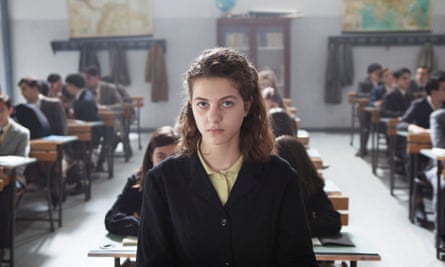“Lila is overdoing it as usual,” Elena Greco begins her story, both in Elena Ferrante’s much-loved novel My Brilliant Friend and in a feverishly anticipated TV adaptation. “We’ll see who wins this time.” And thus a narrative of 50 years of friendship and rivalry opens, transporting us back to the slum Naples district of their postwar childhood.
The first in Ferrante’s Neapolitan quartet, My Brilliant Friend is a breathless, breathtaking love story – but not between a hero and heroine. Above all, the novels are a lingering, obsessive exercise in bringing two young woman into being. While literature is hardly short of female characters scorched on to the page by the male gaze, what makes this book so unusual is that the looking is done by another girl: and in the adaptation the emphasis is all on looking – we watch the girls watching the adult world around them. In the many passages dedicated to noticing that moment when a girl becomes a beautiful woman, Elena’s rapt description of her friend is as charged as that of any lover: “She had become shapely. Her high forehead, her large eyes that she could suddenly narrow, her small nose, her cheekbones, her lips and ears that were looking for a new orchestration and seemed close to finding it.” The reader, like everyone in the neighbourhood, can’t help but fall in love with Lila.
Elena and Lila (Lenù and Lina – even their nicknames are echoes of each other) are two sides of our romanticised selves, constantly shifting in their fragility and fearlessness. And while we know that life is giving Elena chances (all too rare given her background), that her diligence and determination will be rewarded, her insecurities overcome, it is still Lila who we want to be. (Who does not long to be bolder, brainier, beautiful and a little bit bad – brilliant, in short?) But the characters also show us our worst selves: here is true friendship, passionate, sometimes painful and often shamefully ungenerous. They might spend hours lost in Little Women, but this is girlhood as we remember it.

Photograph: ©Wildside/Umedia 2018
While Ferrante is still an enigma, preferring to remain anonymous, her fiction has become a global phenomenon, counting Michelle Obama and Hillary Clinton among its largely, but not exclusively, female devotees (New Yorker critic James Wood and novelist Jonathan Franzen were early champions): her novels have sold in their millions and fans make pilgrimages to the Naples streets on which they are set. So it is a brave and lucky man, Saverio Costanzo who has been chosen to direct and help adapt the novels for the screen.
The most obvious challenge is that so much of the story is related in Elena’s head. But while My Brilliant Friend is a brilliantly sustained exercise in interiority, it is also a noisy, messy, soap opera (as the index of characters, neatly captured in the TV credits by old-fashioned family photo tableaux, suggests). The problem of narration is overcome by a beguiling voiceover that not only adds a nostalgic fatefulness but is fastidiously faithful to the text. And the book’s operatic qualities are creatively exploited: the square is the stage; the women shouting to each other from their balconies like a Greek chorus. The adult events – murder, adultery, breakdowns – happen largely off stage; centre-stage are the childhood dramas, but charged with the same violence and intensity.
Everyone from the elderly to the smallest children are intent on revenge of one sort or another: “We grew up with the duty to make it difficult for others before they made it difficult for us.” Despite the determined domesticity of Ferrante’s novel, which begins and ends with a pair of dolls and a pair of men’s shoes, it is steeped in the bloody history of southern Italy. “Here everything is dangerous.” We meet the girls driving a rusty pin into their flesh, a gesture of daring and solidarity that sets the pattern of their relationship and is picked up in a scene in which they swap their rag dolls, Lila throwing Elena’s in a grate – an act of reckless cruelty immediately mirrored by Elena. This foreshadows the way the girls will alternate and imitate each other over the years, “in a continuous game of exchanges and reversals that, now happily, now painfully, made us indispensable to each other”.
The magnificently recreated neighbourhood of Costanzo’s adaptation appears leached of all colour, the lichen covering the concrete tenement blocks seeming to creep on to the peeling walls inside. It’s as if it has been shot through a dirty glass bottle, producing a claustrophobic, airless atmosphere. The TV version retains the visceral detail of Ferrante’s writing: the incense and restlessness in the church; the chalk, boredom and hormones of the classroom; disappointment and drudgery in the communal stairwells. Men and women inhabit separate domains from the start. The girls’ school uniform smocks are the same green as the older women’s shapeless housecoats, generations mutate into each other – the way in which we are shaped by our environment and the difficulty of escaping our past are perhaps the overriding themes of all Ferrante’s fiction.
Europe is still in the shadows of the second world war, and there are echoes of war films in the dust from passing vehicles, children throwing stones at each other across the street as if over trenches, washing hanging like flags of surrender from the balconies; the rubble of the neighbourhood’s outskirts is a deserted no-man’s land; the new year’s fireworks at which families turn their rockets on each other, a vivid battle scene.
Then, at the beginning of the fourth episode, as Elena enrols in high school in Naples, we are plunged into Technicolor, the drab 50s replaced by the hopefulness of a new decade. Until this point, the muddy palette is stained only by rare splashes of red: the blood of murdered “ogre” Don Achille, Elena’s menstrual blood. In an interview last year, Bruce Miller, another male director of a feminist classic, Margaret Atwood’s The Handmaid’s Tale, said that of all the horrors of the drama, the most controversial was showing a woman’s period on screen.

As with The Handmaid’s Tale, the timing of My Brilliant Friend following the revelations of #MeToo inevitably sharpens its feminist message. “Sure they are handsome, but is that a reason to let them drag us into their car?” a furious Lila demands of her friends about the intimidating Solara brothers, far more explicitly than in the book. “They take Ada and we stay quiet because they are just going to kiss? What if they take you tomorrow? If they take us all, one by one?”
There might be murders and sexual awakenings, but what is really at stake here is getting A grades: what greater betrayal than Elena’s discovery that Lila has been secretly swotting up on her Latin grammar, that she already knows the greek derivation of “gramophone”, that she beats Elena to prizes, despite not being allowed to continue her studies? “She always did the things I was supposed to do before me and better than me. She eluded me when I chased her and at the same time she kept on my heels to overtake me.” In the most significant reversal, that “terrible, dazzling girl” Lila tells Elena at the end: “You’re my brilliant friend, you have to be the best of all, boys and girls.”
A novel with academic rivalry between young women at its heart seems as radical as any overtly feminist text. But where most coming-of-age stories belong only to the one who escapes, Ferrante gives us the other narrative as well (the third novel in the series is called Those Who Leave and Those Who Stay). One reason, perhaps, why these novels are so resonant is that they take the themes that we loved as child readers – friendship and the potential triumph of the bookish outsider – but with adult complexity and without losing any of the exhilarating, agonising, intensity of youth.
As with The Handmaid’s Tale, here is a TV adaptation that is truly sympathetic to its female characters and to the novel on which it is based. And which, in a very different way, is as gripping and ravishing, despite the ugliness and brutality it depicts. While the reclusive Ferrante, in contrast to Atwood, is unlikely to be making any cameo appearances, she has given her screenwriters and audience a great gift: she has already written the material for the next three series herself.

Comments (…)
Sign in or create your Guardian account to join the discussion